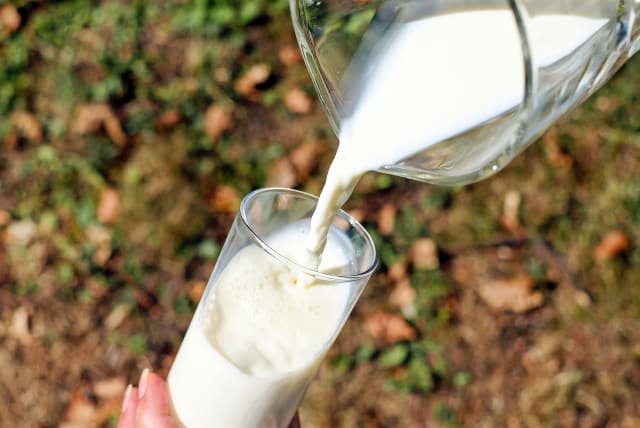Cows can produce more milk if you treat them better, study finds

Be kind to your cows: Dairy cattle can be helped to relax with positive reinforcement, be happier, and produce more milk.
Dairy cows in Israel are among the most prolific milk producers in the world – but there’s always room for improvement. They require a great deal of care while living on a farm. Dairy cattle are often restrained for veterinary procedures, but retraining them can cause fear responses that can make the procedure challenging for both the animal and the human handler.
Positive reinforcement training (PRT ) – training with a reward to achieve a desired behavior – has shown itself to reduce this fear in other species. For their new study in the Journal of Dairy Science published by the American Dairy Science Association and Elsevier under the title “Training dairy heifers with positive reinforcement: Effects on anticipatory behavior,” the researchers wanted to understand whether this training technique holds promise for cattle as well.
They proved that it not only helps shape dairy cow behavior, but can improve their emotional state and overall welfare along the way. Opportunities to learn can reduce distress responses to procedures such as veterinary care, reduce the risk of injury, and help animals feel comfortable with new stimuli.
Researchers: Training with PRT enhances animal welfare
Jennifer Heinsius, a doctoral student in the Faculty of Land and Food Systems at the University of British Columbia in Canada, explained, “A growing body of research shows that training with PRT enhances animal welfare.”
Heinsius noted that as yet, “very little of this research has been devoted to farm animals, so we set out to test the effects of training dairy cows with positive reinforcement in a cattle chute – a common experience for dairy cows undergoing veterinary care or husbandry.”
The team started with a group of 20 Holstein dairy heifers ranging from three-to-six months old, that had previous experience in the cattle chute area and with human handling. The animals were randomly assigned to either a group receiving positive reinforcement training or a control group receiving standard farm handling in the chute. The study involved 28 training sessions for each animal over four days a week with one session per day. Heifers were first brought to a waiting area (“start box”) and were then allowed to enter the training area where they had access to the chute.
For the training group, grain was used as a food reinforcement to move through the stages. Heifers were trained to touch a target with their muzzle; this target was then gradually moved until the animals were fully entering the chute.
Control heifers were also familiarized with the same chute but were not provided a food reward; instead, they were guided by a handler using words of encouragement, calm body movements, and gentle nudging to prevent them from backing up.
To assess how the two groups of animals regarded their experience, the researchers recorded anticipatory and play behaviors during the period when the heifers were waiting in the start box before entering the training area to start their daily training session.
Heinsius explained that “overall, the dairy heifers trained with PRT showed more anticipatory behaviors in the start box than the control group; specifically, they transitioned between behaviors more frequently, indicating they were anticipating the start of their training sessions and the food reward.” The training group also displayed more play behavior, such as jumping and running, indicating that the animals considered the training experience to be positive.
Critically, the increases in play behaviors suggest that positive reinforcement training had a positive effect on the animals’ emotional state before handling, and to our knowledge, this study is the first to assess the effect of training on emotional states in cattle,” Heinsius continued.
The study team stressed the need for further research – such as the long-term benefits of the training –and underscored the practical limitations attached to the time investment required to teach and train individual cows.
“We hope to see future work to improve the efficiency of training methods and working with cattle earlier in life. Promising automated approaches might be developed using existing on-farm automation such as computerized feeders,” she concluded. “Overall, this initial study is a first step to understanding the effectiveness of training heifers using PRT, and the results suggest it could be an important tool to help relieve stress and fear during important on-farm events in a dairy cow’s life, potentially improving the experience for both the animals and their handlers.
Jerusalem Post Store
`; document.getElementById("linkPremium").innerHTML = cont; var divWithLink = document.getElementById("premium-link"); if (divWithLink !== null && divWithLink !== 'undefined') { divWithLink.style.border = "solid 1px #cb0f3e"; divWithLink.style.textAlign = "center"; divWithLink.style.marginBottom = "15px"; divWithLink.style.marginTop = "15px"; divWithLink.style.width = "100%"; divWithLink.style.backgroundColor = "#122952"; divWithLink.style.color = "#ffffff"; divWithLink.style.lineHeight = "1.5"; } } (function (v, i) { });

